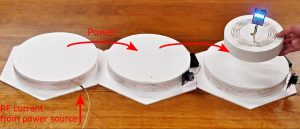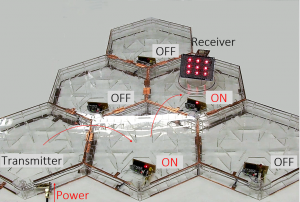
Multi-hop wireless power transmission.
 [図2]マルチホップによる室内給電システム
[図2]マルチホップによる室内給電システムConceptional drawing of 2D wireless power transmission system
 [図3]線状電力ルーティングによる無線電力伝送
[図3]線状電力ルーティングによる無線電力伝送Wireless power transfer with line shape routing
 [図4]線状電力ルーティングによる無線電力伝送の様子
[図4]線状電力ルーティングによる無線電力伝送の様子Picture of wireless power transfer with line shape routing
無線電力伝送とは,文字通りケーブルを使わずに電気機器に給電することであり,ユビキタス社会におけるセンサやロボットの実用的な運用のための重要な技術と考えられています.磁界共振結合方式の無線電力伝送では,コイル状のアンテナ(共振器)に高周波の電流を流し,それによって生じた高周波磁界を介して電力を伝送します.この方式は数十cmの距離を他の手法に比べ高効率給電可能であるため,室内給電への応用が期待されています.磁界共振結合方式では,図2のように送電共振器と受電共振器の間に中継共振器を挟み込むことで送電可能距離を延長することができるという特徴があります.この性質を利用して,図2のように無線給電用の共振器を室内の床や壁にも敷き詰めることにより室内のあらゆる場所に電力供給可能なシステムを実現すべく研究を行っています.このシステムは,安価で導入可能で,施工も容易であるという観点で優れていると考えています.しかし,単純に共振器を配置するだけでは給電を行うことは困難であるため,図3のように共振器をON/OFFすることにより電力をルーティングすることで高効率で給電を行うこと目指しています.既存の設計手法では,任意のホップ数において高効率に給電することは不可能でしたが,当時主流だったフィルター理論からのアプローチを捨てて,共振周波数だけに特化した理論を追求することにより,どのようなホップ数でも高効率で給電可能な共振器の配置手法を提案しています.図4のように,線状ルーティングの実現性は実装により確認しております.図4のシステムでは,送受電共振器を用いた受電器の位置検出を行っており,その位置情報をもとに自動的に電力パスを生成しています.無線電力伝送の分野においては,この技術以外にも,ループアンテナ理論を応用した人体防護のための漏洩電磁界を低減した共振器構造や,最大効率追従のための電力制御手法の考案に取り組んでいます.
Wireless power transmission is the transmission of the energy from a power source to an electrical equipment without using a cable. This technology plays an important role in ubiquitous computing, such as, providing electricity to robots and sensors. There are various forms of wireless power transmission. The magnetic resonant coupling method is one of them, which is suitable for indoor environments because it has an advantage in terms of efficiency within the range of several dozen centimeters. It is also possible to extend the transmission range by putting relay resonators between the transmitting resonator and the receiving resonator like in Fig. 1. Using this feature, we propose a two-dimensional wireless power transmission system, as shown in Fig. 2. In this system, we place multiple resonators in a tiled pattern on the floor as well as on the wall. By switching on each resonator element, the system creates line-shaped virtual power routes to the designated devices. However, the main problem with this system was to maximize the efficiency regardless of the number of relay resonators. Therefore, in this study, we have realized a method which can maintain the efficiency at its maximum in any-hop system. This method is based on impedance matching for any-hop straight wireless power transmission using magnetic resonance. Now, we can efficiently forge virtual routes by using microcomputers and switches as shown in Fig. 4. We confirmed the usefulness of this method from a series of experiments.
【参考文献】
Y. Narusue et al. , “Impedance matching method for any-hop straight wireless power transmission using magnetic resonance,” IEEE Radio and Wireless Symposium, pp.193-195, 2013.
橋詰新, 成末義哲, 川原圭博, 浅見徹, ”二次元共振器アレイ型無線電力伝送のための送受電共振器を用いた受電器の位置検出手法,” 信学技報, vol.115, no.82, WPT2015-33, pp.69-74, June 2015.